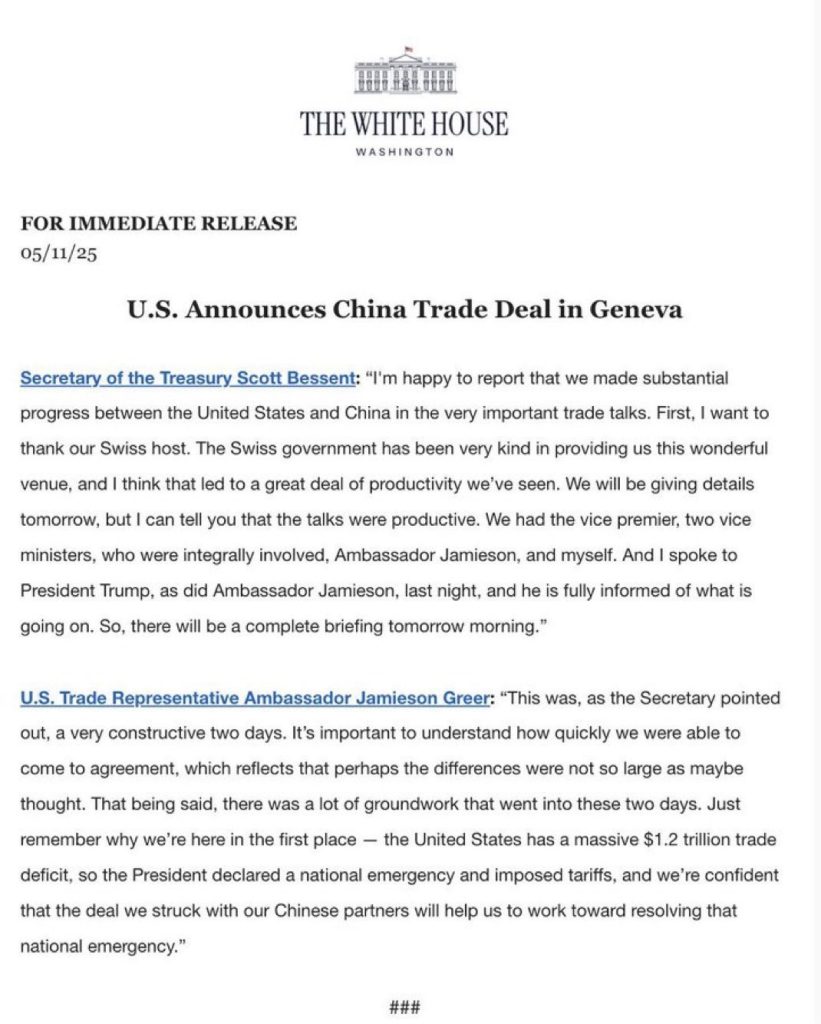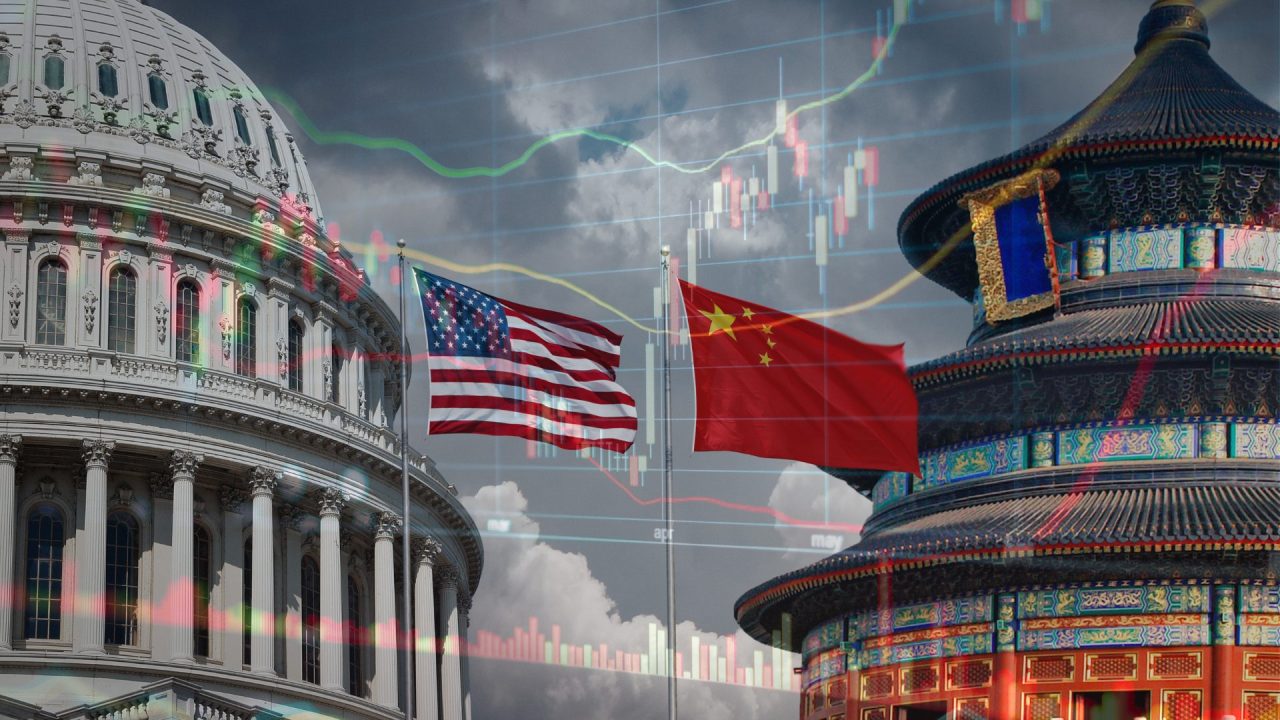Geneva, Switzerland (WNEWS) – In a significant development aimed at de-escalating the ongoing trade tensions between the United States and China, both nations have agreed to a temporary reduction in tariffs for a 90-day period. This agreement was reached after intensive negotiations held over the weekend in Geneva, involving U.S. Treasury Secretary Scott Bessent, U.S. Trade Representative Jamieson Greer, and Chinese Vice Premier He Lifeng.
A Temporary Truce in the Trade War
According to a White House press release issued on May 11, U.S. and Chinese negotiators reached an agreement in Geneva to reduce tariffs and de-escalate trade tensions that had intensified since early April. The deal was finalized by U.S. Treasury Secretary Scott Bessent, Trade Representative Jamieson Greer, and Chinese Vice Premier He Lifeng.
I’m happy to report that we made substantial progress,” Bessent stated. “The Swiss government has been very kind in providing this wonderful venue… we had the vice premier, two vice ministers, Ambassador Jamieson, and myself. And I spoke to President Trump last night. He is fully informed of what is going on.”
The agreement outlines the following:
- Both countries will suspend their recently imposed 34% tariffs for 90 days.
- Tariffs will be lowered by 115% across the board, but a 10% baseline tariff remains in effect on both sides.
- China will eliminate retaliatory and non-tariff measures imposed since April 2, 2025.
- The U.S. will suspend new tariffs from April 8–9 but retain all previous Section 301, 232, and emergency tariffs.
Greer emphasized the broader context: “The United States has a massive $1.2 trillion trade deficit… This deal will help us work toward resolving that national emergency.”
Under the terms of the agreement, the United States will reduce tariffs on Chinese goods from the previous 145% to 30%, while China will lower its tariffs on American imports from 125% to 10%. This mutual reduction is intended to provide immediate relief to businesses and consumers affected by the protracted trade dispute.
The US will still keep all duties imposed on China prior to April 2, 2025, including Section 301 tariffs, Section 232 tariffs, tariffs imposed in response to the fentanyl national emergency invoked pursuant to the International Emergency Economic Powers Act, and Most Favoured Nation tariffs.

The agreement also includes the establishment of a “Geneva mechanism,” a formal consultation process designed to facilitate ongoing dialogue and address future trade issues between the two countries. While this deal marks a significant step towards easing tensions, officials from both sides have emphasized that it is a temporary measure, and more comprehensive negotiations are expected to follow.
I’m happy to report that we made substantial progress between the United States and China in the very important trade talks. First, I want to thank our Swiss host. The Swiss government has been very kind in providing us this wonderful venue, and I think that led to a great deal of productivity we’ve seen. We will be giving details tomorrow, but I can tell you that the talks were productive. We had the vice premier, two vice ministers, who were integrally involved, Ambassador Jamieson, and myself. And I spoke to President Trump, as did Ambassador Jamieson, last night, and he is fully informed of what is going on. So, there will be a complete briefing tomorrow morning.” – Secretary of the Treasury Scott Bessent
China will collaborate with the US to take aggressive actions to curb the flow of fentanyl and other precursors from China to illicit drug producers in North America.
Economic and Political Implications
The trade war, characterized by escalating tariffs and retaliatory measures, has had substantial economic repercussions globally. The recent agreement has been met with cautious optimism in financial markets, with U.S. stock indexes experiencing a rebound and gains observed in Asian and European markets.
Despite the positive market response, skepticism remains, particularly among Chinese citizens who express concerns over the durability of the agreement and the potential for future policy reversals. Analysts also note that while the tariff reductions are a welcome development, the underlying issues that led to the trade conflict, such as intellectual property rights and market access, remain unresolved.
The Trump administration framed both deals as part of a broader effort to reduce dependency on adversarial economies, defend U.S. manufacturing, and respond to the fentanyl crisis. In 2024, the U.S. recorded a $295.4 billion goods trade deficit with China, the largest of any country.
The White House noted:
By imposing reciprocal tariffs, President Trump is ensuring our trade policy works for the American economy… and levels the playing field for American workers and producers.”
Critics, however, argue that these short-term truce deals lack enforcement mechanisms and risk repeating the cyclical nature of U.S.-China trade conflicts observed in 2018-2020.
UK and US Forge New Trade Framework
In a separate but related development, the United Kingdom and the United States announced a new trade framework last week aimed at strengthening economic ties post-Brexit.
The China deal follows another headline-grabbing agreement between the U.S. and United Kingdom announced just days earlier. Though not a full free trade agreement, the framework reduces tariffs and regulatory barriers:
- U.S. drops auto tariffs on up to 100,000 British vehicles from 27.5% to 10%.
- U.K. lifts tariffs on U.S. beef and ethanol and expands agricultural imports.
- Steel tariffs imposed post-Brexit will be eliminated.
While the deal has been hailed as a positive step towards deeper economic cooperation, it stops short of a comprehensive free trade agreement. Critics argue that the agreement offers limited economic impact and serves more as a political gesture than a substantial economic overhaul.
Looking Ahead
The 90-day tariff reduction period between the U.S. and China provides a critical window for both nations to engage in more substantive negotiations aimed at addressing the core issues of their trade relationship. The success of these future talks will be pivotal in determining whether this temporary truce can evolve into a lasting resolution.
Similarly, the UK-U.S. trade framework lays the groundwork for future collaboration, with both sides expressing interest in expanding the agreement into a more comprehensive trade deal. Observers will be closely monitoring the implementation of these agreements and the willingness of all parties to make concessions necessary for long-term economic stability.











